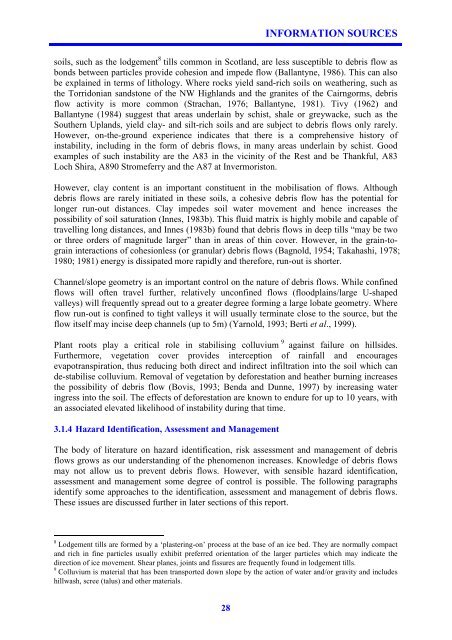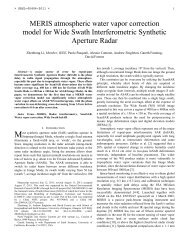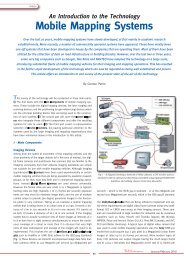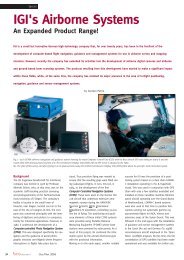Scottish Road Network Landslides Study - University of Glasgow
Scottish Road Network Landslides Study - University of Glasgow
Scottish Road Network Landslides Study - University of Glasgow
Create successful ePaper yourself
Turn your PDF publications into a flip-book with our unique Google optimized e-Paper software.
28<br />
INFORMATION SOURCES<br />
soils, such as the lodgement 8 tills common in Scotland, are less susceptible to debris flow as<br />
bonds between particles provide cohesion and impede flow (Ballantyne, 1986). This can also<br />
be explained in terms <strong>of</strong> lithology. Where rocks yield sand-rich soils on weathering, such as<br />
the Torridonian sandstone <strong>of</strong> the NW Highlands and the granites <strong>of</strong> the Cairngorms, debris<br />
flow activity is more common (Strachan, 1976; Ballantyne, 1981). Tivy (1962) and<br />
Ballantyne (1984) suggest that areas underlain by schist, shale or greywacke, such as the<br />
Southern Uplands, yield clay- and silt-rich soils and are subject to debris flows only rarely.<br />
However, on-the-ground experience indicates that there is a comprehensive history <strong>of</strong><br />
instability, including in the form <strong>of</strong> debris flows, in many areas underlain by schist. Good<br />
examples <strong>of</strong> such instability are the A83 in the vicinity <strong>of</strong> the Rest and be Thankful, A83<br />
Loch Shira, A890 Stromeferry and the A87 at Invermoriston.<br />
However, clay content is an important constituent in the mobilisation <strong>of</strong> flows. Although<br />
debris flows are rarely initiated in these soils, a cohesive debris flow has the potential for<br />
longer run-out distances. Clay impedes soil water movement and hence increases the<br />
possibility <strong>of</strong> soil saturation (Innes, 1983b). This fluid matrix is highly mobile and capable <strong>of</strong><br />
travelling long distances, and Innes (1983b) found that debris flows in deep tills “may be two<br />
or three orders <strong>of</strong> magnitude larger” than in areas <strong>of</strong> thin cover. However, in the grain-tograin<br />
interactions <strong>of</strong> cohesionless (or granular) debris flows (Bagnold, 1954; Takahashi, 1978;<br />
1980; 1981) energy is dissipated more rapidly and therefore, run-out is shorter.<br />
Channel/slope geometry is an important control on the nature <strong>of</strong> debris flows. While confined<br />
flows will <strong>of</strong>ten travel further, relatively unconfined flows (floodplains/large U-shaped<br />
valleys) will frequently spread out to a greater degree forming a large lobate geometry. Where<br />
flow run-out is confined to tight valleys it will usually terminate close to the source, but the<br />
flow itself may incise deep channels (up to 5m) (Yarnold, 1993; Berti et al., 1999).<br />
Plant roots play a critical role in stabilising colluvium 9 against failure on hillsides.<br />
Furthermore, vegetation cover provides interception <strong>of</strong> rainfall and encourages<br />
evapotranspiration, thus reducing both direct and indirect infiltration into the soil which can<br />
de-stabilise colluvium. Removal <strong>of</strong> vegetation by deforestation and heather burning increases<br />
the possibility <strong>of</strong> debris flow (Bovis, 1993; Benda and Dunne, 1997) by increasing water<br />
ingress into the soil. The effects <strong>of</strong> deforestation are known to endure for up to 10 years, with<br />
an associated elevated likelihood <strong>of</strong> instability during that time.<br />
3.1.4 Hazard Identification, Assessment and Management<br />
The body <strong>of</strong> literature on hazard identification, risk assessment and management <strong>of</strong> debris<br />
flows grows as our understanding <strong>of</strong> the phenomenon increases. Knowledge <strong>of</strong> debris flows<br />
may not allow us to prevent debris flows. However, with sensible hazard identification,<br />
assessment and management some degree <strong>of</strong> control is possible. The following paragraphs<br />
identify some approaches to the identification, assessment and management <strong>of</strong> debris flows.<br />
These issues are discussed further in later sections <strong>of</strong> this report.<br />
8<br />
Lodgement tills are formed by a ‘plastering-on’ process at the base <strong>of</strong> an ice bed. They are normally compact<br />
and rich in fine particles usually exhibit preferred orientation <strong>of</strong> the larger particles which may indicate the<br />
direction <strong>of</strong> ice movement. Shear planes, joints and fissures are frequently found in lodgement tills.<br />
9<br />
Colluvium is material that has been transported down slope by the action <strong>of</strong> water and/or gravity and includes<br />
hillwash, scree (talus) and other materials.

















